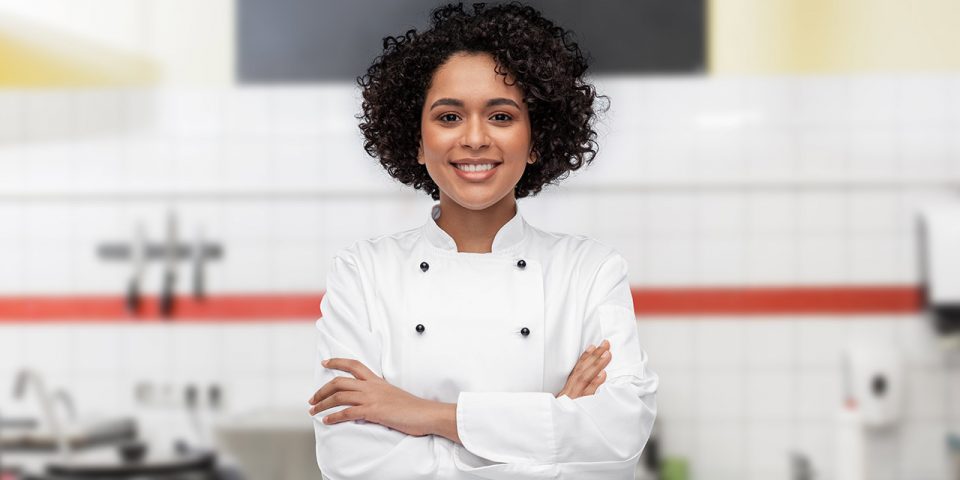In the fast-paced world of professional kitchens, Executive Chef coats—also known as Chef jackets—stand as more than just a uniform. They symbolize authority, tradition and professionalism, reflecting the critical role of an Executive Chef as a leader in the culinary industry.
Designed to distinguish them from other staff, Chef coats also ensure practicality and protection in the often chaotic kitchen environment.
In this article, we’ll delve into the history of Chef coats, explore their features that support the demanding role of an Executive Chef, compare traditional and modern styles and provide tips on choosing the perfect Chef coat.
The History of the Executive Chef Coat
The first Executive Chef coat was introduced in 1822 by Marie-Antoine Carême, known as the world’s first celebrity Chef, having cooked for royalties, including George IV and Tsar Alexander I of Russia.
He designed the modern outfit as we know it today, with a Chef wearing a white hat, a double-breasted coat and an apron.
Almost 60 years after Carême illustrated what Chefs wear, Angelica Uniform Group started mass-producing this uniform to make it available for all service industry employees.
This design is what inspired the stylish Chef coats we see in kitchens today.
Features of an Executive Chef Coat
Since it was made available to the public, the Executive Chef coat has gone through many changes to adapt to modern times. But here are the five classic features that remain part of its design:
High collar
Executive Chef coats have Mandarin collars to protect Executive Chefs’ necks from heat and spills in the kitchen. It also keeps their neck from chafing when wearing bib aprons.
Aside from protection, this collar style also adds elegance to the uniform, contributing to the authoritative appearance of Executive Chefs.
White color
While the thought of using white-colored clothing may seem counterintuitive, it serves a purpose in keeping Executive Chefs cooler since light colors absorb less heat.
Another reason behind choosing white is its association with cleanliness.
Customers’ affinity toward a restaurant is often tied to their perception of its cleanliness. Given that kitchen work exposes Executive Chefs to spills and stains, their ability to keep their uniform spotless after a whole day working with sauces, soups and marinades showcases their dedication to cleanliness.
Double-breasted design
An Executive Chef’s coat features overlapping wide front flaps and two rows of buttons on each side when fastened. The overlapping cloths help Executive Chefs remain presentable if the front flap gets soiled but they need to meet with stakeholders, chat with a guest in the dining room or serve at an event.
Aside from helping them maintain a clean appearance, which sets the standard for the rest of the kitchen staff, it also protects them from heat and steam.
Long sleeves
Long sleeves are included in the design for the Executive Chef’s protection and comfort.
Sleeves that extend up to the wrists make for an effective makeshift towel to swiftly and safely get food out of the oven. Additionally, when making a trip from the hot kitchen to the freezer, they help reduce the shock of sudden temperature change.
Buttons
The Executive Chef’s jacket comes with two rows of buttons. The buttons can come in different types such as knotted, melamine and nylon studs.
The two rows of buttons help ensure that the coat stays secure when worn. They fasten either way, making them appropriate for both men and women.
Executive Chef Coat: Traditional vs Modern
Below, we’ve listed the differences between traditional and modern Executive Chef coats.
Traditional:
- Usually made with heavy cotton or canvas
- Only uses white color
- Generally made with longer sleeve length
- Features double-breasted design
- Minimalist style
Modern :
- Made with light fabrics such as polyester and cotton blends
- Comes in a variety of colors, including black and denim
- Provides a choice to use short sleeves
- Offers an option of a single set of buttons
- Can be customized using embroidery
In addition, modern Chef coats have sleeve pockets to hold pens and thermometers. Some uniforms have side pockets to carry larger items such as mobile phones.
To summarize, traditional Chef coats were created with functionality and durability in mind. Meanwhile, modern Chef coats focus on comfort and design.
How To Choose the Right Executive Chef Coat
Choosing the right Executive Chef coat depends on a lot of factors, including the restaurant’s target audience, branding and kitchen tasks.
Whether you’re opting for a traditional, all-white minimalist approach or a more expressive style with embroidery, here are some factors to consider:
Comfort
Look for lightweight fabrics such as cotton or a cotton and polyester blend, as these materials are breathable. In addition, these fabrics can withstand frequent washing, making them suitable for long-term use.
Functionality
While Executive Chef coats with a single button-down front are lighter and offer better ventilation, a double-breasted design provides more protection from heat, spills and steam.
Consider the bulk of the tasks Executive Chefs in your restaurant will be performing to know which design is more suitable for their needs.
You may also consider coats with pockets so they can conveniently carry and use thermometers, pens and other tools.
Style and cut
Although coats are generally unisex, women’s Chef coats nowadays are created with slimmed side panels and a tapered waist. Consider choosing a style specifically designed for different body types for ease of movement and better fit.
For those working in fine dining restaurants, choosing a French cuff instead of the more common turnback cuff can make Chefs look more elegant.
Conclusion: Timeless Elegance Meets Modern Innovation
The Executive Chef coat is more than a uniform—it’s a symbol of leadership, professionalism, and culinary heritage. Whether opting for a traditional white coat with double-breasted features or a modern, customized design, the right coat equips Executive Chefs with confidence and comfort to excel in their roles.
By understanding the history, features, and evolving styles of Chef jackets, culinary professionals can choose the ideal coat that reflects their personality, enhances their performance, and aligns with their restaurant’s brand.
FAQs About Executive Chef Coats
Chef coats are traditionally white to symbolize cleanliness and professionalism. The color also keeps the Chef cool by reflecting heat, making it practical in hot kitchen environments.
The double-breasted design provides extra protection against spills and heat. It also allows Chefs to reverse the front panels to cover stains, maintaining a presentable appearance.
Yes, modern Chef coats can be customized with embroidery, logo designs and additional features like pockets, making them more personalized and functional.
Not necessarily. Modern Chef coats offer short-sleeve options for increased ventilation and comfort, though long sleeves remain popular for their protective benefits.
Wash Chef coats in cool or warm water with a gentle detergent to preserve fabric quality. Pre-treat stains immediately to keep the coat looking pristine.




